Can c be used on linux?
C can be used on Linux. The method of using C on Linux is: 1. Write a C program example and save it with a ".c" extension; 2. Use the gcc compiler in a terminal To compile the program and generate the target file, the command is "gcc -o my_program my_program.c"; 3. Execute the "./my_program" command.

#The operating environment of this tutorial: linux5.9.8 system, Dell G3 computer.
Can I use c on linux?
Can.
Writing your programs in C on Linux
| It is really simple, Consists of three simple steps. |
Step 1: Write your C program and save it with a .c extension. For example, my_program.c.
Step 2: Use the gcc compiler in a terminal to compile the program and generate the object file, like this:
gcc -o my_program my_program.c
Step 3: In Linux, you can run your C program the same way you run the generated object file:
./my_program

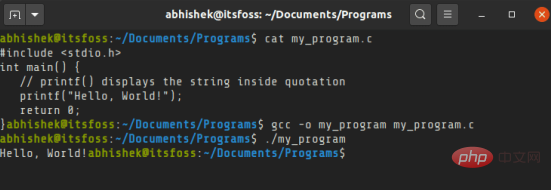
This is just how to compile and run C in Linux A brief summary of the procedure. Assuming you are new to the C language or Linux systems, I will walk you through the steps so that you can feel comfortable writing C programs in a Linux environment.
In fact, I will discuss two ways of running C programs in the Linux terminal and in the code editor.
Method 1: Run a C program in a Linux terminal
In order to run a C program in Linux, you need to have a C compiler on your system. The most popular compiler is gcc (GNU Compiler Collection).
You can install gcc using your distribution's package manager. In Linux distributions based on Debian and Ubuntu, use the apt command:
sudo apt install gcc
Switch to the directory where your C program is saved (or provide the path), and then compile the program to generate the object file:
gcc -o my_program my_program.c
Remember, providing an output object file (-o my_program) is optional. If you do not provide it, an object file named a.out will be automatically generated. But this is not good, because every C program compiled will overwrite it, and you don't know which program this a.out object file belongs to.
After your object file is generated, run it to run the C program. It has been able to perform. Simply use it like this:
./my_program
Next, if your program is correct, it will show you the output you expect. As you can see, this is no different than running a C program in Linux.
Each time you change your program, you must first recompile it and then run the resulting object file again to run the new C program.
Method 2: How to use a code editor such as VSCode to run C programs in Linux
Not everyone is comfortable with the command line and Terminal, I totally understand that.
You can use a real C/C IDE such as Eclipse or Code Blocks, but they are very heavyweight programs and are usually better suited for larger projects.
I recommend using an open source code editor like VSCode or Atom. They are basically text editors, but you can install add-ons to compile and run programs directly in the graphical code editor.
In this example, I use the VSCode editor. It is a very popular open source code editor from Microsoft.
First, install VSCode in Ubuntu’s Software Center. For other distributions, check your Linux distribution's package manager or software center. You can check out its official website for more information.
Start VSCode, open or create a project, and create your C program here. I'm using a simple Hello World program as an example.

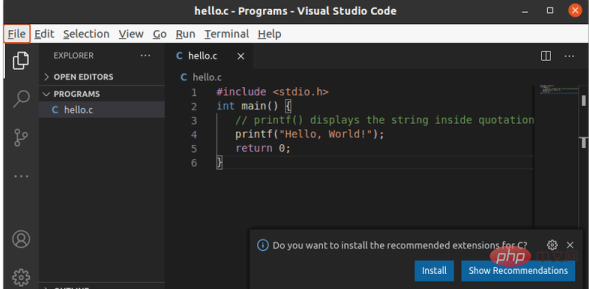
#You must make sure you have the gcc compiler installed on your Linux system.
sudo apt install gcc
The next thing you need to do is use an extension that allows you to run C code. Microsoft may prompt you to install its C/C++ extension, but it's complicated to set up, so I don't recommend it.
Instead, I recommend you use the Code Runner extension. It is a simple and straightforward extension that allows you to easily run C and C++ code without additional configuration.
Go to the Extensions tab, search and install "Code Runner" there.

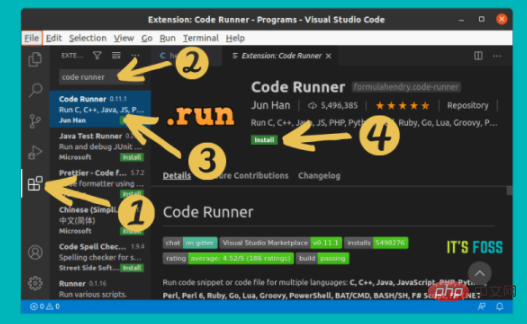
Install the Code Runner extension to run C/C programs
Restart VSCode. You can now run C code using one of the following methods:

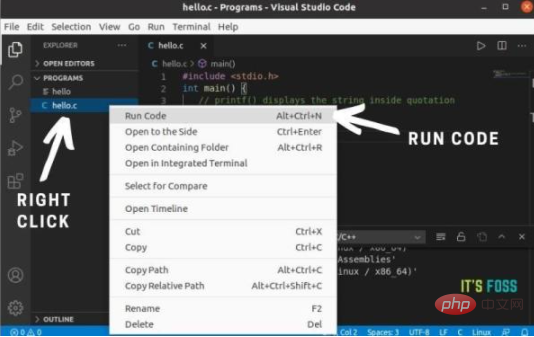
Right-click the program file and select Run Code
When you run this C program, it will be automatically compiled and run. You can see the output in the terminal that opens at the bottom of the editor. Is there anything better than this?

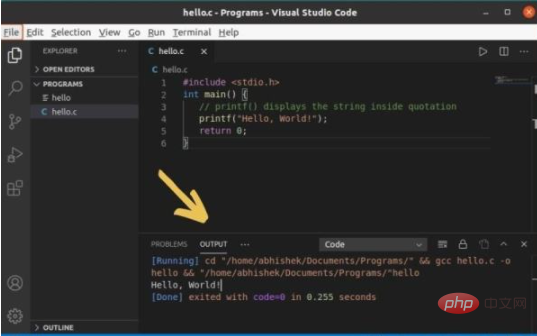
#Program output is displayed at the bottom of the editor
Which method do you prefer?
It's no problem to run some C programs from the Linux command line, but using a code editor will be easier and save time. Do not you think so?
You can decide which method you want to use.
Use the shortcut Ctrl Alt N .
Press F1, then select or enter “Run Code”.
Right-click in the text editor and click "Run code" from the context menu.
Recommended study: "linux video tutorial"
The above is the detailed content of Can c be used on linux?. For more information, please follow other related articles on the PHP Chinese website!

Hot AI Tools

Undresser.AI Undress
AI-powered app for creating realistic nude photos

AI Clothes Remover
Online AI tool for removing clothes from photos.

Undress AI Tool
Undress images for free

Clothoff.io
AI clothes remover

Video Face Swap
Swap faces in any video effortlessly with our completely free AI face swap tool!

Hot Article

Hot Tools

Notepad++7.3.1
Easy-to-use and free code editor

SublimeText3 Chinese version
Chinese version, very easy to use

Zend Studio 13.0.1
Powerful PHP integrated development environment

Dreamweaver CS6
Visual web development tools

SublimeText3 Mac version
God-level code editing software (SublimeText3)

Hot Topics
 1672
1672
 14
14
 1428
1428
 52
52
 1332
1332
 25
25
 1277
1277
 29
29
 1257
1257
 24
24
 Linux Architecture: Unveiling the 5 Basic Components
Apr 20, 2025 am 12:04 AM
Linux Architecture: Unveiling the 5 Basic Components
Apr 20, 2025 am 12:04 AM
The five basic components of the Linux system are: 1. Kernel, 2. System library, 3. System utilities, 4. Graphical user interface, 5. Applications. The kernel manages hardware resources, the system library provides precompiled functions, system utilities are used for system management, the GUI provides visual interaction, and applications use these components to implement functions.
 vscode Previous Next Shortcut Key
Apr 15, 2025 pm 10:51 PM
vscode Previous Next Shortcut Key
Apr 15, 2025 pm 10:51 PM
VS Code One-step/Next step shortcut key usage: One-step (backward): Windows/Linux: Ctrl ←; macOS: Cmd ←Next step (forward): Windows/Linux: Ctrl →; macOS: Cmd →
 How to check the warehouse address of git
Apr 17, 2025 pm 01:54 PM
How to check the warehouse address of git
Apr 17, 2025 pm 01:54 PM
To view the Git repository address, perform the following steps: 1. Open the command line and navigate to the repository directory; 2. Run the "git remote -v" command; 3. View the repository name in the output and its corresponding address.
 How to run java code in notepad
Apr 16, 2025 pm 07:39 PM
How to run java code in notepad
Apr 16, 2025 pm 07:39 PM
Although Notepad cannot run Java code directly, it can be achieved by using other tools: using the command line compiler (javac) to generate a bytecode file (filename.class). Use the Java interpreter (java) to interpret bytecode, execute the code, and output the result.
 How to run sublime after writing the code
Apr 16, 2025 am 08:51 AM
How to run sublime after writing the code
Apr 16, 2025 am 08:51 AM
There are six ways to run code in Sublime: through hotkeys, menus, build systems, command lines, set default build systems, and custom build commands, and run individual files/projects by right-clicking on projects/files. The build system availability depends on the installation of Sublime Text.
 What is the main purpose of Linux?
Apr 16, 2025 am 12:19 AM
What is the main purpose of Linux?
Apr 16, 2025 am 12:19 AM
The main uses of Linux include: 1. Server operating system, 2. Embedded system, 3. Desktop operating system, 4. Development and testing environment. Linux excels in these areas, providing stability, security and efficient development tools.
 laravel installation code
Apr 18, 2025 pm 12:30 PM
laravel installation code
Apr 18, 2025 pm 12:30 PM
To install Laravel, follow these steps in sequence: Install Composer (for macOS/Linux and Windows) Install Laravel Installer Create a new project Start Service Access Application (URL: http://127.0.0.1:8000) Set up the database connection (if required)
 git software installation
Apr 17, 2025 am 11:57 AM
git software installation
Apr 17, 2025 am 11:57 AM
Installing Git software includes the following steps: Download the installation package and run the installation package to verify the installation configuration Git installation Git Bash (Windows only)




